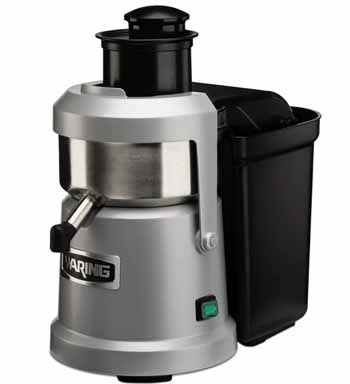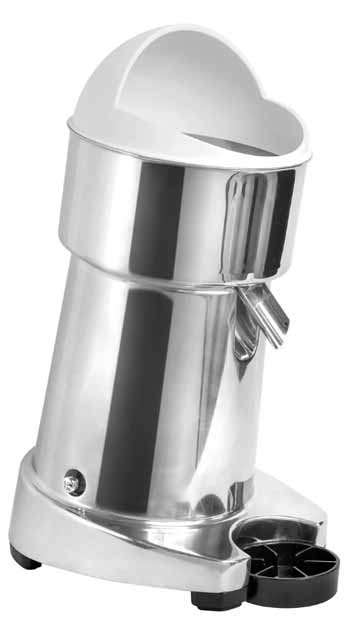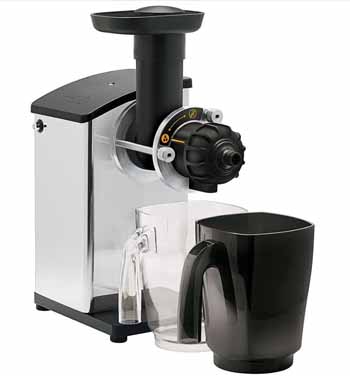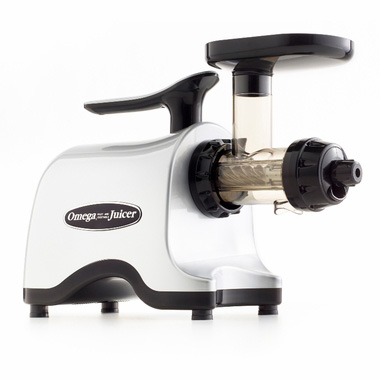To open a juice bar or a storefront that serves fresh-squeezed juices and smoothies, you’ll need a prime location, savvy business plan, and juicing equipment.
Average starting costs range between $20,000–$400,000, and average annual revenue is around $100,000–$600,000. Successful juice bars require hard work, creativity, and a passion for fresh foods.
The most important 11 steps to open a juice bar successfully are:
Step 1: Learn How Juice Bars Work
Before you open your own juice bar, it’s important to understand the ins and outs of how juice bars operate. Juice bars serve freshly prepared beverages, such as cold-pressed or fresh-squeezed juices and fruit smoothies. Other popular menu items include protein shakes, juice shots packed with vitamins, and simple food items like sandwiches and salads.
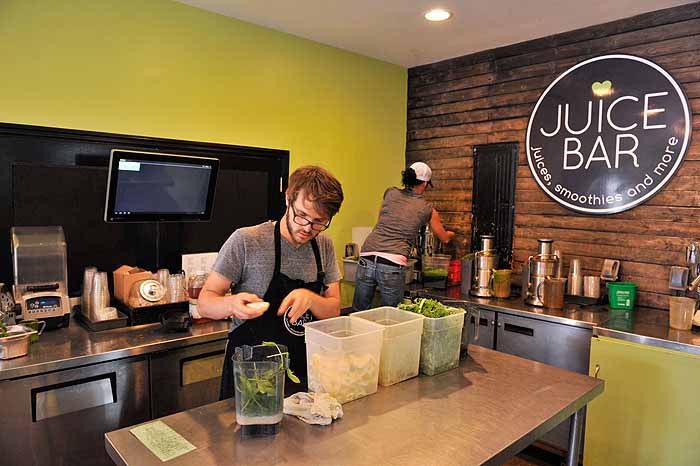
A look at the kitchen of Juice Bar in Huntsville, Alabama. (Source: Huntsville/Madison County Convention & Visitors Bureau)
The best way to learn how juice bars operate is by working for a juice bar. Before starting your own business, consider working for a successful juice shop to see how juices are created and the day-to-day aspects of running a juice bar.
If getting first-hand experience at a juice bar is not an option, you must do market research. Study successful juice bars in your area, including their marketing campaigns and advertising efforts, menu items, peak times, number of employees, and operating hours.
Step 2: Create a Budget
Budgeting for your future business will be more of an educated guess than an exact science. But creating some roadmaps and guidelines is still important to ensure your cash flow remains healthy.
Your business likely won’t make a profit for months—if not years—after opening. As such, you need to figure out how much you can invest and how much outside funding you’ll receive, and then create a plan for covering all of your expenses.
First, determine how much money you will need to open your business. Consider storefront costs, construction costs, juicing equipment, license and permits, etc. Then, determine what your monthly fixed and variable expenses are. Fixed expenses are things like your storefront rent payment or your phone bill, which will not frequently change. Variable costs are more fluid, like the cost of juicing ingredients or marketing campaigns.
The most difficult part of setting your budget is estimating your monthly sales after you open. Be as realistic as possible and err on the side of caution. It’s always better to bring in more money than expected than to come up short.
Once you have those figures, subtract your fixed and variable costs from your expected monthly sales—the result is your estimated cash flow. Again, it is best to have a large contingency fund in place to use to cover expenses if you do not meet your sales goals upon opening.
Step 3: Write a Juice Bar Business Plan
Once you are familiar with how juice bars operate, you’ll need a juice bar business plan. Business plans are necessary for securing funding, like bank or small business loans. Plus, having a business plan will give you an idea of what to expect financially and help you iron out a plan to ensure your business becomes profitable.
Here are the nine elements found in a typical business plan:
- Executive summary: An introductory paragraph outlining your company’s purpose, mission, and why it will be successful.
- Business description: Describe what need or market hole your juice bar is filling in the community, who your customers will be, and the talent on your team.
- Market analysis: Write an overall outlook on the juice bar industry, including trends, what successful competitors are doing, and what your strengths will be.
- Organization and management: Outline who will be running your business and the experience your team members have in juicing, health and wellness, restaurant, or retail environments.
- Product line: Outline what kinds of juices you will sell, along with any other food or beverage items. Include research on why you’re selecting those products, such as sales trend data or specific health benefits.
- Marketing and sales: Describe your general marketing strategy and your plan for attracting and retaining customers.
- Funding requests: If you need outside funding, outline your needs and specify exactly how you will use the funds.
- Financial projections: Detail how your business will become stable and profitable, including a projected financial timeline of at least five years. If you are borrowing funds, include a plan on how you will be able to repay the loan.
- Appendix: Use this space for any supplemental documents, such as logo or branding designs, sketches of what your juice bar will look like, credit histories, licenses, permits, etc.
When writing a business plan, use the format and software you are most comfortable with. Many people opt to use a traditional word processor like Microsoft Word or Google Docs. You can also create your business plan in a presentation format using PowerPoint. Alternatively, there are business plan software programs that guide you through the process and come with easy-to-use templates.
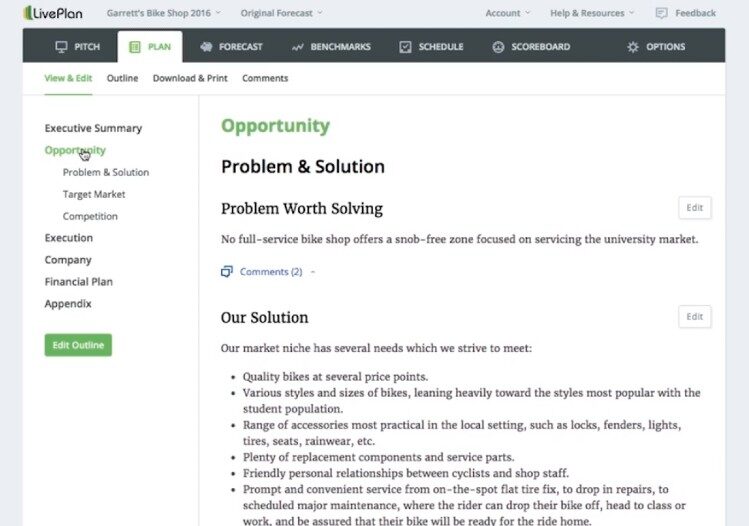
LivePlan is a popular business plan software that makes writing a business plan easy.
Juice Bar Franchise Options
Instead of opening an independent business completely on your own, you can choose to open a juice bar franchise location. Franchises provide built-in name recognition, a proven business model, and national or regional marketing efforts. Typically, franchisors even offer guidance on managing day-to-day operations with set policies and procedures. Plus, franchises have the advantage of operating under an enterprise-scale parent company—meaning they can negotiate better deals with suppliers.
However, starting a franchise can be very expensive. Opening a juice bar franchise can cost between $150,000 to $500,000+ altogether, including franchise fees, construction, and other up-front fees. After opening, you’ll also pay royalties on the sales you bring in, and a percentage of your net sales will go toward the company’s advertising budget.
Popular juice bar franchises and their requirements include:
Company | Franchise Fee | Total Investment Range | Royalty Fee (% of total sales) | Advertising Contributions (% of total sales) | Required Minimum Net Worth | Required Minimum Liquid Capital |
|---|---|---|---|---|---|---|
Smoothie King | $30,000 | $320,301–$1,184,865 | 6% | 3% (plus 2% required local advertising spend) | $300,000 | $100,000 |
Jamba Juice | $35,000 | $248,200–$843,000 | 6% | 3% | $350,000 | $125,000 |
Freshii | $30,000 | $200,000–$470,500 | 6% | 1.5% (plus 1.5% required local advertising spend) | $300,000 | $150,000 |
Robeks Fresh Juice and Smoothies | $30,000 | $245,000–$394,500. | 7% | 2.5% | $300,000 | $100,000 |
Clean Juice | $45,000 | $274,500–$576,000 | 6% | 2% | $500,000 | $120,000 |
Tropical Smoothie Cafe | $30,000 | $277,000 – $584,000 | 6% | 3% (plus 2% required local advertising spend) | $350,000 | $125,000 |
Planet Smoothie | $25,000 | $190,150–$421,500 | 5% | 2% | $250,000 | $125,000 |
Booster Juice | $30,000 | $325,000–$375,000 | 6% | 3.5% | $500,000 | $130,000 |
Nekter Juice Bar | $35,000 | $216,000–$622,00 | 6% | 2% (plus 2% required local advertising spend) | $400,000 | $100,000 |
Smoothie Factory | $15,000* | $143,600–$254,600 | 5% | 3% | $250,000 | $100,000 |
*Smoothie Factory franchise fees are reduced by 50%—from $30k to $15k—as a promotion during 2023. Nontraditional locations (such as kiosks or food court spaces) charge a lower franchise fee (regularly $15k; $7.5k during promotion).
Choose the Best Legal Structure for Your Juice Bar
Choosing a legal structure for your business is important because it determines how you will collect and report taxes, how you will get paid from your business, and what your level of personal liability is. There are many types of legal structures, but the two most commonly found in small businesses such as juice bars are sole proprietorships and limited liability companies (LLCs).
Sole Proprietorships are the default legal structure your business will fall under if you don’t register for an LLC. Sole proprietorships lump together your personal and business finances, which means your business income is considered personal income. However, it also means that if anything goes wrong (lawsuits, bankruptcy, etc.), your personal assets such as your house and car could be at risk. Some retail business owners opt for a sole proprietorship, but this legal structure is mainly used by freelancers and consultants.
An LLC is the most popular legal structure for small retail and restaurant businesses because it separates your business assets from your personal assets, providing a degree of personal protection in the case of bankruptcy. From a tax perspective, LLCs are similar to sole proprietorships.
Organize Your Finances
Having your personal and professional bank accounts separated enables you to monitor expenses and track tax deductions. Plus, if you opt for an LLC business structure, separating your finances is necessary for protecting your personal assets.
When choosing a small business checking account, look for one with few-to-no fees for your daily financial transactions that also offers outstanding products and services—like lending products, merchant services, and access to interest-earning accounts. Check out our list of the best small business checking accounts.
Step 4: Choose a Location for Your Juice Bar
As with any storefront, the location you choose for your juice bar can make or break your business. So where do you start, and how do you know which areas will be most profitable?
First, narrow down the geographic area by considering what’s practical. When you open your juice bar business, you’ll be putting in long hours every day, so make sure you choose a location with a commute that is feasible.
Once you’ve narrowed down a geographic radius, analyze the different neighborhoods. Here are the different elements to consider when choosing a location:
- Health-conscious consumers: Juice bar customers are typically health-conscious, so look for areas with successful yoga studios, gyms, spas, and other wellness businesses.
- Neighborhood demographics: Juice bars typically appeal to customers between the ages of 16 and 35, and require some level of ancillary income to patronize. Aim for a location with a population that aligns with your target audience.
- High-traffic areas: You’ll want to put your business in front of as many people as possible, so look for downtown strips, main streets, and shopping malls that already have lots of patrons.
- Sidewalks and foot traffic: Juice bars are great at attracting walk-in customers, especially during the summer months, so try to place your store in a pedestrian-friendly area.
- Parking availability: Your store will also need to be accessible for customers that drive to your business, so make sure there is plenty of parking available.
- Other juice bars: Don’t open a juice bar too close to an existing juice business—that will put you at a disadvantage right from the beginning.
Your budget is the other important element to consider when choosing a location for your juice bar. Splurging on a prime, high-traffic location may be worth it since a considerable amount of your business will likely come from walk-in and impulse shoppers, regardless of where your store is located. But, as a general rule of thumb, food and drink businesses should not spend more than 6%–10% of their monthly gross sales on rent.
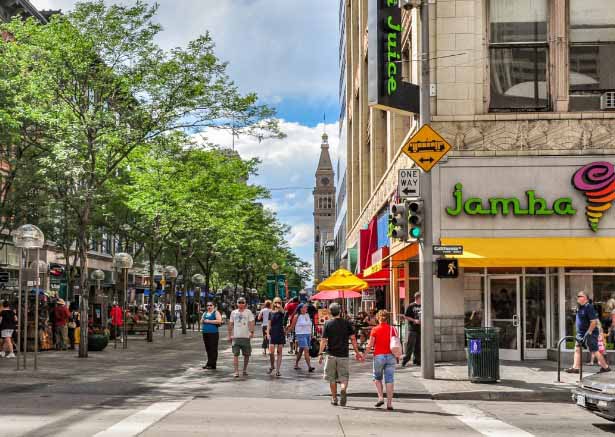
Choosing a corner location within a pedestrian mall, like the Jamba Juice shown above, can provide the greatest amount of foot traffic. That being said, these spots typically rent for some of the highest prices. (Source: Kent Kanouse, Uncover Colorado)
Step 5: Lease & Outfit Your Storefront
Once you’ve selected a location, it’s time to go to work on designing, building, and outfitting your juice bar. A well-designed shop can create an inviting atmosphere and help boost sales, while a poor layout can make your juice bar feel cramped and crowded.
Designing a juice bar can be a little more complicated than a regular retail store because of the different plumbing, electrical, and sanitation requirements needed. Here are some of the key considerations when designing your juice bar:
- Health code requirements for commercial kitchens (varies by state)
- Plumbing, electrical, and ventilation required for kitchen and juicing areas
- Proper food storage space and waste disposal
- Sanitation strategy
Place the Checkout Counter
A well-placed checkout counter will open up your floor space and allow for lines and waiting areas that don’t interfere with seated customers. Many juice bars find success by having seating areas toward the front of the store with the counter for ordering and payments toward the back.
In traditional retail store layouts, the inside right wall is your “power wall” or display. With a juice bar, the power wall is your menu. The left side of the store, which typically gets the least amount of foot traffic and visual attention from customers, is a great spot for customer seating.

This juice bar utilizes a narrow space by arranging seating on either side of a walkway that leads to the checkout counter. (Source: The Juice Pod)
Create a Welcoming Environment
Similar to coffee shops, many juice bars encourage customers to sit down and stay a while—whether they’re working on their laptops or chatting with friends. The more time customers spend in your store, the more money they will spend on your products. Make sure you have plenty of comfortable seating, play gentle music, and offer free Wi-Fi.

The Organic Buzz Juice Bar features homey, comfortable seating that encourages customers to stick around after receiving their order. (Source: TripAdvisor)
Outfit Your Juice Bar Checkout
Once your counter is placed, you’ll need a point-of-sale (POS) system installed to manage your orders, sales, and inventory. Using a POS saves time and provides deeper insights into your sales, inventory, customers, and employee data. Many POS systems also offer built-in payment processing, which means you only have to deal with one solution provider.
There are many factors to consider when selecting a POS. Before you start seriously considering different options, it’s important to write down a wish list of what features you want. Some of the criteria we typically use to evaluate POS systems include:
- Price: Most POS software programs charge a monthly fee, and some also charge extra for certain features.
- Ease of use: Take advantage of free trials to test out different systems and to make sure the interface is easy to navigate; also read user reviews to be aware of any glitches or common problems.
- Inventory management: Make sure the solution you use has features for ingredient-level tracking so that your stock counts stay accurate after each customer order is fulfilled.
- Customer management tools: Almost all POS systems have a customer directory feature, but otherwise, they vary greatly in what loyalty, marketing, and customer feedback features are included.
- Ecommerce functions: Some POS solutions have features for creating a website or setting up online orders.
For many juice bar startups, we recommend using Lightspeed. It offers an easy-to-use cloud-based POS system that operates on iPads and has features like real-time inventory management, menu customization, sales reporting, and integrated payment processing with an offline mode. Visit Lightspeed for a free trial.
Step 6: Purchase Juicing Equipment
You’ll also need to purchase commercial-grade juicing equipment for your store. The specific appliances you’ll need depend on what kind of menu items you offer. But investing in high-quality equipment is important so that your tools can grow with your business and you don’t need to worry about replacing or repairing appliances.
Here are some of the pieces of equipment you’ll need for your juice bar:
- Commercial blenders
- Juicers
- Refrigerators
- Ice machines
- Scales and measuring tools
- Quality knives
- Cutting boards
- Storage containers
- To-go cups for juices
- Napkins and utensils
Different Types of Commercial Juicers
There are four main types of juicers, each with different purposes and price points. For your business, you may decide you want just one type of juicer or a combination of two, three, or all four.
Here’s a rundown of the four primary juicer types:
Sourcing Fruits and Vegetables
You will also need a steady supply of fresh fruits and vegetables. Try to source locally whenever possible—you’ll get the freshest ingredients possible and save on shipping or freight costs. Purchasing directly from local farms or orchards is also typically less expensive than purchasing from a wholesale food distributor.
Step 7: Design Your Recipes & Menu
Before opening your juice bar, you’ll also need to develop your menu and juice recipes. If you’re new to juicing, finding the perfect recipes and ingredient levels can take some trial and error. Make sure you take the time to research popular ingredients and combinations, and have friends and family sample your recipes for feedback.
Popular juice ingredients and trends include:
- Celery juice
- Carrot-based juices
- Green blends with spinach, apple, kale, etc.
- Citrus blends
- Exotic fruit blends including dragon fruit, guava, mango, or passion fruit
- Juices with a subtle, spicy kick from ginger, cayenne, or chili peppers
- Health-boosting add-ons like chia seeds, medicinal mushroom powders, turmeric, coconut or CBT oil, maca root, and collagen powder
Many juice bars also offer light food options, like yogurt parfaits; Acai bowls topped with fruits, seeds, nuts, and grains; salads; and sandwiches. If this is something you want to do in your juice bar, make sure your kitchen area is prepared and up to local health codes for food as well as juice.
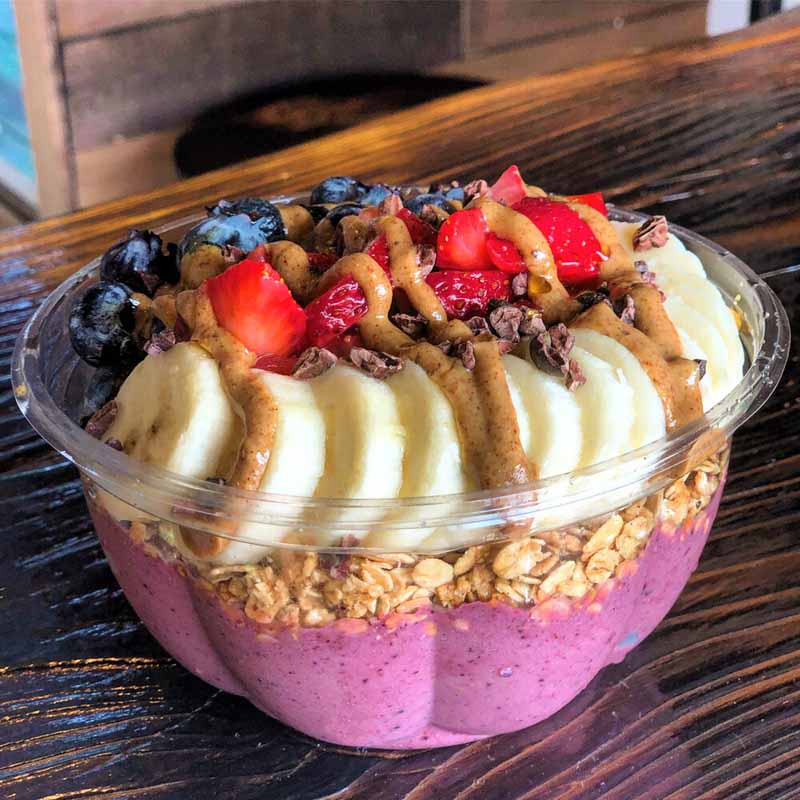
Acai bowls—made from blended frozen Acai fruit with generous, flavorful toppings—have become a popular juice bar staple in recent years. (Source: Thrive Juice Lab)
Step 8: Build a Juice Bar Branding Strategy
To successfully open a juice bar business, you will also need a branding strategy and marketing plan. You’ll want to develop a logo, color scheme, and a plan for attracting customers to your business. For most local stores, effective marketing strategies involve a combination of digital and traditional tactics. But the basics include designing a logo and creating a website.
Create a Logo
First, you’ll need to create a logo for your business. Your logo should be distinctive, versatile, and graphic. In other words, it shouldn’t be too text-heavy. Instead, try to come up with a concept or symbol that is a good representative of your juice bar. Keep in mind you will use your logo on your website, on your menus, on to-go cups, on your store signage, and more.
The good news is, you don’t have to be a Photoshop wiz or professional designer to make a logo. There are many cheap (or even free) logo design websites. Popular options include Canva, Looka, and LogoMakr.
Build a Website
Having a website for your juice bar is crucial—primarily because it will help potential customers find and learn about your business when searching on Google.
Creating your own website from scratch is not as complicated as it sounds. There are many easy ways to make a business website for little or no money. You just need a registered domain and a web hosting service.
Squarespace is a popular and affordable web-building tool for small business owners. The easy-to-use platform offers plenty of elegant templates to create a professional-looking site that showcases your juice. Squarespace also partners with online ordering systems like ChowNow so your customers can get juice delivered to their door.
Step 9: Hire & Train Employees
Before opening your juice bar to the public, you’ll need to hire a group of outstanding employees to serve as the front lines of your business. If you haven’t hired an employee before, navigating the process can be really intimidating. Be sure to go through a new hire checklist that outlines all of the steps you need to take—such as obtaining an Employer Identification Number (EIN), registering for state and local taxes, and so on.
Start the hiring process by writing attractive and compelling job descriptions. Figure out what positions you need to fill (manager, shift supervisor, associate, etc.) and what qualities you are looking for in a candidate Finally, add thorough info about your company and why your future employees will love working there.
Keep in mind that you’ll train your employees on how to prepare your recipes, take care of your store, and provide great customer service—so select candidates with the qualities you can’t train for, like work ethic and enthusiasm.
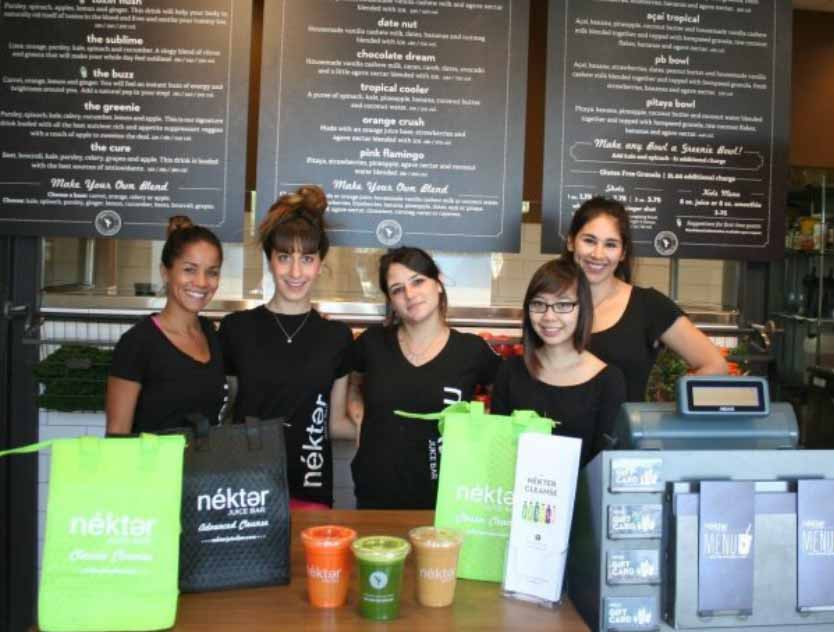
Juice bars typically rely on a small, tight-knit staff to operate, so look for trustworthy employees with relevant experience. (Source: Glassdoor)
Once your staff is hired, it’s important to start training well before you open your juice bar. Practice makes perfect, and skills like juicing and customer service are no different. You want your staff ready to deliver outstanding service to your customers from the minute your store opens. In order to do that, hold a paid training “boot camp” where you practice customer service skills, review recipes, outline expectations, and teach staff about the products and menu items in your store. Find ways to incorporate games and contests to keep the training engaging.
Payroll and HR
Once your staff is hired, you’ll need to handle the HR side of things—including onboarding, payroll, benefits, and performance management.
In lieu of hiring a full HR staff, many small businesses opt to use an HR software or service, like Gusto (shown below). Read our list of the best HR software for small businesses to learn more.
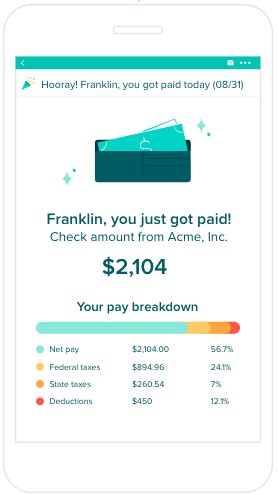
Gusto notifies employees via email every time they receive a direct deposit. (Source: Gusto)
Step 10: Plan a Grand Opening
When opening a new local business, you want to really make a splash and draw attention from the community. The best way to do this is by planning a grand opening event.
Make sure your event is well-attended by recruiting friends and family and starting your advertising efforts as soon as you have a date planned. You can draft a press release to send to local media outlets and neighboring businesses, create an event on Facebook, or take an ad out in the local paper.

Movita Juice Bar celebrated its grand opening with enticing deals, raffle prizes, samples, and celebrity appearances. (Source: Downtown Long Beach Alliance)
Use Your Local Chamber of Commerce
Your local Chamber of Commerce has plenty of experience with grand openings and will help you plan yours if you sign up as a member.
In addition to sharing tips and best practices, the Chamber of Commerce also has lots of connections in the community and a vast network of other business owners. They will likely help you advertise the event, and even recruit a few other local businesses to attend and show support.
Some Chamber of Commerce chapters also have agreements with local papers or local elected officials to have them attend business openings. Having your event documented in the local newspaper is a great way to boost visibility.
Step 11: Advertise Your Juice Bar
Once your business is open, the work has just begun. You will need to put continuous effort into advertising your juice bar and attracting customers through marketing.
Your online reputation can be the deciding factor on whether or not a customer will try your business, so be sure to include digital marketing in your advertisement strategy. Here are some ways to get started:
Manage Online Reviews
Managing online reviews is vitally important for small businesses, especially during the startup phase. You want to know what customers are saying about you online so you can know what your customers like and what you need to work on.
Responding to reviews also shows potential customers that you are invested in the customer experience and that you take their feedback seriously. The best way to stay on top of your reviews is to sign up for a Yelp! Business account.
Use Social Media
Yelp! Is an important tool, but it is not the only social platform you should use to advertise your business. Facebook and Instagram are also crucial tools for managing customer feedback and promoting your business.
Create a Facebook Business Page with your hours, contact, and website information—then post regularly to advertise different juices, promotions, and events. For just a few dollars a day, you can also create a Facebook ad to reach thousands of potential customers.
Register Your Juice Bar on Google
Another important step in advertising your business is registering it on Google. The service (called Google My Business) is free for business owners and allows you to create a profile that will appear in relevant search results.
You’ll be able to set hours, contact information, and even share information like special promotions. Registering your business with Google will also make your juice bar appear on Google Maps.
Tips for Opening a Juice Bar
Opening a juice bar is a huge endeavor. Once you open your doors, there are several strategies you can use to help boost sales and keep customers coming back for more:
Tap Into Trends
Health food trends change extremely fast; pay attention to industry trends and add or alter menu items accordingly to make sure you’re always offering what your customers are looking for.
Offer Programs & Cleanses
In addition to individual made-to-order juices, consider selling pre-set kits or programs. Cleanses are especially popular during spring and summer months, and in January with New Year health-related resolutions.
Other customers simply enjoy drinking fresh or cold-pressed juice each day and want to buy a pack to take home. You can boost sales by offering packs and cleanses either made to order or prepackaged in a display refrigerator.
Offer a Loyalty Program
Many POS systems, such as Lightspeed, offer a loyalty program feature. Consider adding this to your store to help drive repeat visits and repeat sales.
Traditional punch-card loyalty programs can work, but digital loyalty programs allow you to track customer usage and engagement and send messages to customers about rewards or promotions. To learn more, read our guide to creating a customer loyalty program.
Account for Seasonal Changes
Consumers associate juice bars with fresh ingredients. Consider offering seasonal juice blends that take into consideration which fruits and vegetables are in season. Seasonal menu items and limited edition items can also help drive sales.
Juice Bar Frequently Asked Questions (FAQs)
A juice bar serves freshly squeezed or freshly pressed juice and smoothies. Juice bars offer both prepared and made-to-order beverages, and often cater to health-conscious consumers.
Fast casual restaurants typically have an average profit margin of 6%–9%. Juice bars tend to earn margins on the higher end of that range (or greater), largely thanks to the simplicity of their offerings.
The average revenue for juice bars ranges from $100,000 to $600,000. Your business could earn more or less depending on location, overhead costs, and customer volume.
Opening a juice bar storefront usually costs anywhere from $20,000–$400,000 on average, but some stores rack up costs of over $1 million. Franchises are typically the most expensive option but can yield greater and faster profits.
Opening a juice bar kiosk or juice bar food truck is significantly less expensive, typically costing $25,000 to $100,000
The factors that contribute to the total cost of opening a juice bar include:
- Location
- Construction/remodeling
- Utilities
- Permits/licenses
- Interior design
- Equipment
- Marketing, branding, and PR
- Contingency funds
Bottom Line
With careful planning, thoughtful recipes, and a comprehensive juice bar business plan, opening a juice bar can be a fun and profitable endeavor.
The US juice and smoothie market is currently valued at $2.3 billion and continues to grow about 7% each year. So, if you’ve been thinking about opening a juice bar, there’s never been a better time to start.
